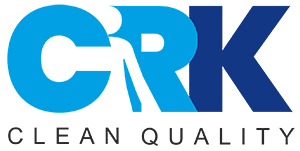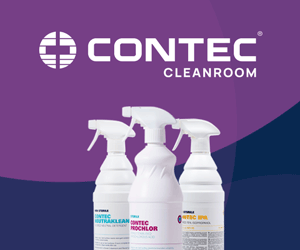Control of micropollutants is a key aspect in the process of maintaining ISO and GMP cleanliness. Dust and microbiological contamination affects the maintenance of environmental parameters of cleanrooms, the personnel, materials and waste flow and, most importantly, contributes to the risk of cross-contamination and, consequently, the risk of contamination of the final product.
The sanitation process is multi-stage and varied depending on the industry to which it is applied. Cleaning will be different in rooms where automotive details or electronics are produced, versus the areas of pharmacy and medical device manufacturing. However, a set of parameters can be distinguished, identical for each of the areas requiring the sanitation process, which include:
- Achieving maximised contamination control including removal of particles, liquids, bacteria/viruses and reduction of electrostatic charge transfer
- Obtaining the lowest possible operating costs related to less labour, amount of detergents and water used, and longer life of cleaning accessories
- Optimisation and ergonomics of the cleanliness operator's workplace
- Full compliance with legal regulations such as ISO 14644-5, IEST RP CC018 and GMP
- Presentation of quality certificates confirming the possibility of using the system in cleanrooms
- Compliance with the concept of sustainable development and environmental friendliness
- Obtaining acceptance and greater motivation of the cleanliness operator in the context of using ergonomic, effective and health and safety solutions
- Development and implementation as well as effective implementation of SOP procedures in the cleaning programme
Depending on the declared ISO class, we can also indicate questions/areas for discussion that will allow for an effective and optimised approach to the selection of the system. Considering the processes in terms of their criticality, we can divide the areas into main (production and auxiliary) and the so-called 'production-related' (preparatory rooms for passenger and material locks and service windows).
Why is the bucket method not always the best?
Production zones
These areas require a sanitation validation process and regular control/monitoring of airborne contamination, surfaces and those transferred on the personnel.
In order to prepare well for choosing a proper washing system, you need to conduct a risk assessment and analyse a few key issues:
- What kind of contamination do you need to remove?
- Are the bio-pollutant clean-up targets being achieved with the current sanitation method? Dust pollution?
- Does the preferred system have efficiency reports for the particle collection on the mops and cloths?
- Do cleaning materials (mops/cloths) collect and remove surface contamination? How is this confirmed?
- How often do the operators of the cleaning service change the working liquid and mops?
- Does the total cost of a cleaning programme matter in the context of the organisation?
- Does the cleaning staff participate in regular training on the sanitation and disinfection process?
Auxiliary zones
Auxiliary zones are essential in the process of maintaining the appropriate parameters of critical and production zones. Properly prepared SOP procedures and a properly developed sanitation schedule and cleaning programme make it possible to reduce the amount of pollution brought into the main rooms by up to 80%.
In the area of auxiliary rooms, additional considerations should be made related to:
- Validation of the washing system to establish a contamination barrier
- System unification by using the same methods/tools during cleaning procedures, thus facilitating the work of cleaning operators obtaining information on the global costs of maintaining cleanliness in auxiliary zones
Facilities can be divided into ‘main’ areas and so-called ‘production-related’ areas
Personal and material locksThe area of passenger and material locks carries the greatest risk of contamination transmission to the production area. Contamination is most often caused by a poorly handled process of changing protective clothing, the lack of hand washing and disinfection, as well as an excessively liberal approach to the subject of regular sanitation and disinfection of the mucus surfaces.
In order to properly implement the cleaning programme, in addition to the issues mentioned in the above content, you should take into account such aspects as:
- Simplicity of introducing working liquids into the personal and material lock during the sanitation system preparation process
- Is the surface of the personal and material locks sufficient to perform the bucket filling preliminary preparation?
- Is there a problem with transporting trolleys within the lock area and to the main and auxiliary rooms?
- Is there any problem with the access to the surface under devices, shelves, benches?
Sanitation methods
The easiest way to restore the proper microbiological and particle cleanliness is to use the standard, traditional bucket method. The bucket method is a method that uses a system that usually consists of two or more buckets, into which clean water is introduced - without a washing-disinfectant - dedicated to rinsing mop pads, and water with a washing-disinfecting agent, used to soak the pad and distributing the fluid on a dedicated surface. The bucket method can use disposable or reusable pads, most often polyester or non-woven cellulose-polyester mops. This method is a two-stage process, that gives a great saving in the consumption of mop covers by rinsing them in clean water and allowing for the sanitisation of even very large areas of cleanroom at a time.
At the same time, the bucket method may generate some limitations when sanitising clean zones so it is not always the best to choose? This is mainly due to the following aspects:
- The need to change the water to soak and rinse the cleaned surfaces
- The need to add a new portion of the washing-disinfecting agent each time during water changes
- The need to leave the cleanroom or support with the participation of an additional employee who will replace the water with clean water and replenish washing and disinfecting agents
- The need to supervise the operator to confirm that he performed each step of the water change in the right way and at the right time
The above examples confirm that the use of the bucket method in cleanrooms is not always possible and does not always have a positive effect on the sanitation process of the clean zone.
Areas can be divided into ‘main’ areas and so-called ‘production-related’ areas
Alternative to the bucket method
Achieving the maximum level of pollution control, as well as appropriate ergonomics and cost savings, is only possible with good optimisation of the cleaning and disinfection process. Where the bucket method cannot be used, or where the user is anxious to bring the sanitation process down to one comprehensive step, the pre-treatment method is the best choice.
This method is based on the use of a cuvette system into which an appropriate, calculated number of mop covers is inserted. This amount is determined by dividing the total area of the room by 20, as one overlay can be used to sanitise 20 sqm of space (internal validation of the sanitation process must be performed). The overlays are placed in a cuvette and poured over with the appropriate amount of the washing-disinfecting agent working solution. Importantly, there is 200-250 ml of solution for one cap.
The most important advantages of the pre-washed system are:
- Optimising the need to vacuum the room
- The mop covers are pre-soaked, there is no direct contact of the operator with the working solution, which significantly affects the cleanliness and the possibility of undesirable spread of water in the room
- The mops are made in microfibre technology, which causes the release of a very small amount of water droplets on the cleaned surface
- No need to use detergents with simultaneous streak-free cleaning of the surface
- Precise cleaning of even hard-to-reach surfaces, thus washing out even the most microscopic crevices, where bacteria and dust pollution could accumulate
- Maximum limitation of the amount of water, which is particularly important for GMP A/B/ISO Class 5 cleanliness classes, where open water sources are not allowed to use
- No need for additional personnel - all sanitation can be performed by one person
- Ability to disinfect and sterilise the system quickly and safely store cleaning accessories in cleanrooms
Regardless of the method used to sanitise the controlled zone, the system must meet the requirements of maximum control of particle pollution and bio-pollutants, including determination of the ISO/GMP cleanliness class of the room, material and personnel load, identification of ESD zones, zones particularly exposed to microbiology, and staff numbers. All these elements will have an influence on the choice of system.
Additional components such as ergonomics and economic considerations will determine user preferences. It is important that the chosen method of cleaning brings the best results to maintain the environmental parameters of the rooms, and thus the safety of the product, materials and personnel.





